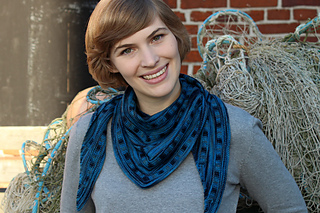patterns >  Meermädchen
Meermädchen
> Waterkant








Waterkant
Eine deutsche Anleitung ist erhältlich. - The pattern is available in English.
Waterkant ist ein symmetrisches Dreieckstuch, das ein handgefärbtes Multicolor-Garn optimal zur Geltung bringt. Die kraus rechten Streifen entstehen mithilfe der Farbverläufe und durch ein Wechseln der Strickrichtung, ein glatt rechts gestrickter Teil dazwischen sorgt zusätzlich für eine lebendige Struktur. Da das Tuch eine geradlinige Form hat und auch gut in gedeckteren Farben gearbeitet werden kann, ist es absolut männertauglich. Die Größe kann leicht an die individuellen Vorlieben angepasst werden.
Das plattdeutsche Wort “Waterkant” bezeichnet die nordeutsche Küste. So sagt man bei uns “Ick bün vun de Waterkant.” und meint “Ich komme vom Meer.”
Die Linienführung des Tuches und die gestrickten Streifen lassen mich an eine Küstenlinie denken, denn sie spiegeln die Geradlinigkeit der norddeutschen Küstenlandschaft wider: Deiche, Dünen, Molen, Hafenmauern…
Übrigens: Da das Tuch nahtlos in einem Stück gearbeitet wird, muss man am Ende keine lästigen Fäden vernähen!
Bitte vor dem Anstricken beachten: Damit das Muster besonders lebendig wirkt, ist es wichtig, dass die Farbrapporte nicht zu kurz sind. Die Farblängen pro Farbe im von mir verwendeten Garn betragen ca. 20 - 40 cm.
Verwendete Techniken: rechte und linke Maschen, Maschen zusammenstricken, wickeln & wenden (in der Anleitung erklärt), Maschen aufnehmen und abstricken, links und rechts verschränkte Zunahmen (in der Anleitung erklärt).
Garn: 135 g Wollmeise Pure, Farbe Wasserratz
Maße meines fertigen Tuchs (Verbrauch: 135 g): 34 cm x 120 cm
Im Download-Bereich der Library befindet sich ein Photo-Tutorial mit vielen hilfreichen Hinweisen.
Waterkant is a symmetrical triangular shawl, which shows off a handpainted multicoloured yarn in a beautiful way. The garter stitch stripes develop by changing the knitting direction along with the help of the colour sequences, a stockinette part additionally provides a vivid structure. Since the shawl’s shape is rectilinear and muted colours will obtain as great results as bright ones, it is eminently suitable for men. The size can be easily adjusted to your preferences.
The northern German coast is referred to as “Waterkant” in Low German. Like they say “Ick bün vun de Waterkant.” which means “I live at the sea-side.”
The shawl’s classic lines and the knitted stripes remind me of the shore line, since they reflect the rectilinearity of the northern German coastal landscape: dikes, dunes, piers, docks…
By the way: The shawl is worked seemlessly in one piece so there are no troublesome threads to weave in at the end!
Please read this before you start knitting: For maximum effect make sure that the colour repeats of your yarn are not too short. The colour repeats of the Wollmeise yarn I used are 20 cm - 40 cm long (per colour).
Required techniques: knit and purl stitches, knit 2 stitches together, wrap & turn (explained in the pattern), pick up and knit stitches, make one left and right (explained in the pattern).
Yarn: 135 g Wollmeise Pure, colour Wasserratz
Measures of my finished shawl (I used 135 g): 13.5” (34 cm) x 47” (120 cm)
There is a photo tutorial with helpful information available in the download section.
83953 projects
stashed
151905 times
- First published: October 2013
- Page created: October 4, 2013
- Last updated: October 13, 2014 …
- visits in the last 24 hours
- visitors right now




